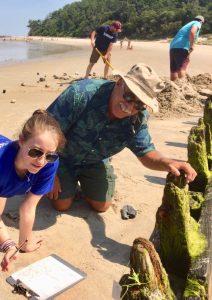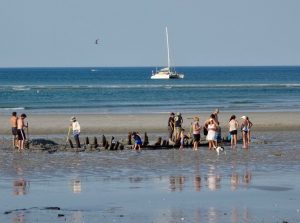by Emily Mathay

Victor T. Mastone (he insists you call him ‘Vic’) is an expert on shipwrecks. As Director and Chief Archaeologist for the Massachusetts Board of Underwater Archaeological Resources (BUAR), he’s the one to call about any project involving water: “The ocean, the intertidal, every river, lake, pond, stream, puddle…basically if it’s got standing water in it, I have regulatory jurisdiction. And the state owns the resource if it’s cultural.”
Vic’s Boston office is an explosion of paperwork, with clippings of archaeology-themed comics from the Sunday papers and photos of family and friends on the walls. As I walk in, my eye is drawn to a poster of Albert Einstein tacked onto a cabinet door that reads: “If you can’t explain it simply, you don’t understand it well enough.” Vic started out as an engineering student before transferring to University of Massachusetts Boston to get undergraduate degrees in both history and anthropology and received both an MA in anthropology (archaeology) and an MBA in arts administration from SUNY Binghamton, while also working on archaeology projects inland and along the coast of the Northeast. (“I didn’t get to go to all the fun places like Alaska or Morocco.”) While in his MBA program, he interned at the Peabody Museum of Salem (now the Peabody Essex). Through this work, he became connected with the BUAR, who hired him in 1987 as their first staff archaeologist and appointed him Director in the early 90s.
The job of chief archaeologist is part regulatory and part public engagement. A self-described “policy-wonk,” Vic spends much of his time working with permit holders, evaluating projects for environmental or statutory compliance issues, conducting research, and giving technical advice to other agencies or members of the public. All-told, he reviews about 1,000 projects a year. As engaging as he finds this regulatory work, he calls outreach his “salvation” — sharing his love of shipwrecks and underwater archaeology with the public helps recharge him for the work that needs to be done in front of a computer.
Vic divides his outreach into two categories: intentional and spontaneous. Intentional outreach involves answering reference questions, responding to calls from people who have found odd things on beaches, writing articles, tutoring with the Nautical Archaeology Society, conducting summer programs with local schools and community groups, giving public talks, and various other education programs. Spontaneous outreach occurs when he’s been summoned to a particular site and interacts with random passer-by while he takes measurements and notes on the shipwreck: ”I’ll tell them the story — what we’re doing, what we’re seeing…providing real-time interpretation. To me, everyone is a student.”
As in other cultural heritage institutions, work in the government sector  requires a proactive approach to internal advocacy. For example, Vic works to ensure that policies and regulations cover cultural heritage sites, explaining to lawmakers why such sites are important to Massachusetts history. He also forms partnerships with and performs grant reviews for federal agencies and serves on various boards and committees. Because he is a department of one, inreach is critical to maintaining his position, so he makes himself an indispensable regulator, collaborator, and resource for other agencies. This is where Vic’s practicality shines — he prioritizes requests from both his and other government departments, triaging what’s important and responding quickly and efficiently. He also phrases his responses in ways that relate to their projects. One example he gave was a shipwreck that was in the way of some expensive machinery. Vic’s argument was that the machine would need to be replaced once it rammed its way through the wreck, which would cost much more than simply avoiding the wreck in the first place.
requires a proactive approach to internal advocacy. For example, Vic works to ensure that policies and regulations cover cultural heritage sites, explaining to lawmakers why such sites are important to Massachusetts history. He also forms partnerships with and performs grant reviews for federal agencies and serves on various boards and committees. Because he is a department of one, inreach is critical to maintaining his position, so he makes himself an indispensable regulator, collaborator, and resource for other agencies. This is where Vic’s practicality shines — he prioritizes requests from both his and other government departments, triaging what’s important and responding quickly and efficiently. He also phrases his responses in ways that relate to their projects. One example he gave was a shipwreck that was in the way of some expensive machinery. Vic’s argument was that the machine would need to be replaced once it rammed its way through the wreck, which would cost much more than simply avoiding the wreck in the first place.
Vic is retiring soon. He hopes that through his outreach efforts, people developed a deeper appreciation of cultural resources. It’s not about saving everything — Vic doesn’t mind people climbing all over the wrecks, since this helps disabuse them of the notion that these artifacts are “sacred.” Instead, outreach is about encouraging people to take a second look, rather than being dismissive of strange things found on the beach. He hopes that in the end, we can all see that “these things have worth, and that it’s important to us as human beings…the past is important to us.”
